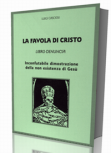THE HOLY SCRIPTURES
In the gospel we read that Jesus was the master of
a squad of twelve disciples, that Mary Magdalene was
the woman who washed his feet at Bethania and that Lazarus
was the brother of Mary Magdalene and also the son of
Giairo. See the miracle of the resurrection (Mt.9,18-Mc.
5,11-Lc. 8,4-Gv.11). ( To understand the paternity ascribed
to Giairo it is sufficient to consider that all four
stories, even if they change in some details, refer
always and in any case to the same person, i.e. Lazarus).
HISTORICAL TEXTS
Out of the historical texts is resulting that Jesus
has been constructed on the person of John, the firstborn
son of Judas the Galilean and leader of a band of revolutionaries
(Bohanerges).
From Flavius Josephus we learn that Lazarus, son of
Giairo, was bound by parental ties with Manahem, son
of the same Judas the Galilean. ( Judean war ... )
It's from this kinship that we can, not only confirm
the existence of the marriage, but also get an ulterior
historical proof of the non-existence of Jesus because
of this kinship that would result incomprehensible if
the husband was really the son of Joseph and not of
Judas the Galilean as results from the innumerable affirmations
which came to us from the historical texts.
Menahem and Lazarus, being brothers of two spouses,
one from a man and one from a woman, confirm us with
their kinship of brothers in law that the marriage existed
and that the spouse was the firstborn son of Judas the
Galilean.
That Jesus, alias John of Gamala, was the husband of
Mary Magdalene is once more confirmed by other documents
telling us about this band of Bohanerges by the falsifiers
transformed in a group of disciples, preachers of peace:
From the gospel of Philip discovered in Egypt in 1945
during an important archeological research: "Mary,
who was the spouse of the Lord, went everywhere with
him. The Lord loved Mary Magdalene more than he did
any of the other disciples and often kissed her on the
mouth in front of everyone".
The papyrus 8502 of Berlin, called the gospel of Mary,
mentions that the other disciples were jealous and resentful
because of the predilection the Lord felt for Mary:
"Perhaps the Lord has spoken secretly to his wife
before speaking to us and without doing it openly? (
here it is Simon, the other son of Judas the Galilean,
who is speaking) Do we have to humiliate ourselves and
submit to her? Perhaps he prefers her above us?"
From the coptic gospel we learn that Peter openly argued
against Mary Magdalene: " Simon, called Peter,
said to the other disciples: - Mary should leave us
because women are unworthy of life - and the Lord, hearing
these words, turned to them and spoke: - Behold, I will
guide her making her a male, so that she will become
a combatant like us -.
Already the contempt alone that Simon displays against
women saying that they are unworthy of life, would be
enough to prove that here we have to do with a band
of judean rebels followers of the most extremistic Mosaic
laws.
At this point I think it is not too rash to suppose
that among the people present at the supper there was
also Mary Magdalene, the combative wife of John of Gamala
the leader of the Bohanerges band. - ( From the book
"The Fable of Christ", Cap.12, edited on the
first of January 2002, when nobody had yet discovered
that in "The Last Supper" of Leonardo Da Vinci
the face of a woman was concealed in that of the disciple
John, disciple who, as a matter of fact, wasn't there,
could not be there, because the true apostle loved by
Jesus was Lazarus. But this is part of another chapter.
In the hope that I've been useful for the resolution
of the main questions that came out after the publication
of the book "The Da Vinci Code", I greet cordially
all my friends and enemies, whether intelligent or idiots.
Luigi Cascioli.



